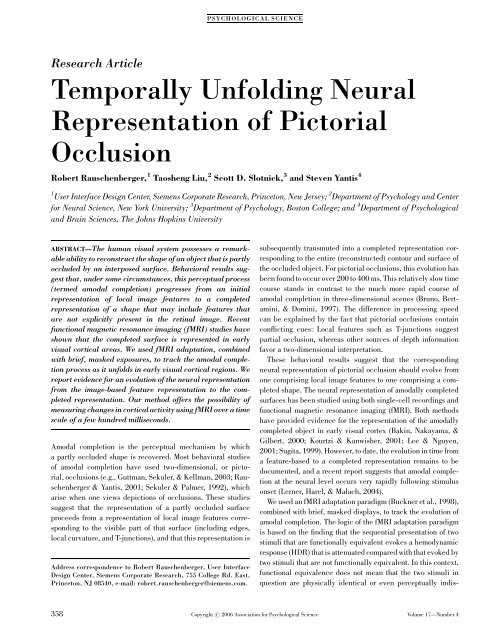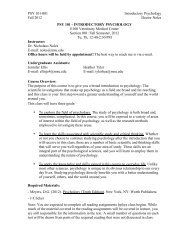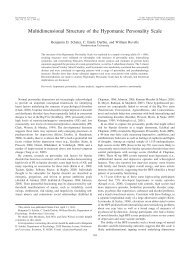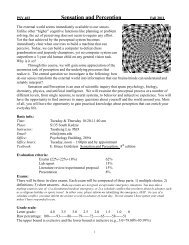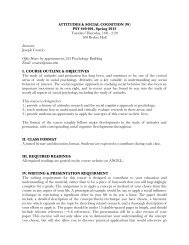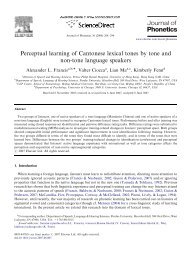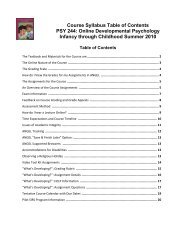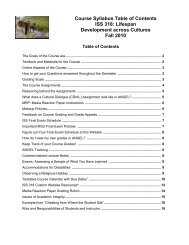Temporally Unfolding Neural Representation of Pictorial Occlusion
Temporally Unfolding Neural Representation of Pictorial Occlusion
Temporally Unfolding Neural Representation of Pictorial Occlusion
Create successful ePaper yourself
Turn your PDF publications into a flip-book with our unique Google optimized e-Paper software.
R. Rauschenberger et al.Fig. 1. Stimuli and procedure for the notched and complete conditions.tinguishable, but rather that they receive equivalent internalrepresentations (Kourtzi & Kanwisher, 2001).We determined, at two different points in time (100 and 250ms after stimulus onset), whether a partly occluded object isrepresented as a collection <strong>of</strong> local features explicitly present inthe retinal image or as a completed shape in which occludedcontours have been recovered. We accomplished this by observingthe magnitude <strong>of</strong> HDR attenuation when a pictorialocclusionprime was followed either by a stimulus whose localfeatures unambiguously matched those <strong>of</strong> the prime or by astimulus that unambiguously matched a completed interpretation<strong>of</strong> the prime. Accordingly, a pictorial-occlusion prime(notched disk abutting a square) was exposed for either100 or 250 ms and was then followed by one <strong>of</strong> two unambiguousprobe displays (see Fig. 1): either one corresponding to thecompleted interpretation <strong>of</strong> the preceding disk (complete condition:complete disk overlapping a square) or one correspondingto an unambiguously notched disk (notched condition:notched disk near a square). We refer to these conditions with aletter indicating the form <strong>of</strong> the probe (C for complete, N fornotched) and the duration <strong>of</strong> the prime (100 or 250 ms).If there were no evolution <strong>of</strong> the neural representation <strong>of</strong> thepictorial-occlusion prime, and the prime were treated as functionallyequivalent to a complete disk even in brief exposures,the HDR evoked in the C100 condition would be comparable tothat in the C250 condition (see Fig. 2a). In other words, therewould be no difference in response to the complete-disk probeacross exposure durations. Furthermore, if the prime’s neuralrepresentation were complete almost immediately—even at100-ms exposures—as has been claimed recently (Lerner et al.,2004), the response evoked in the C100 condition would beattenuated compared with that in the N100 condition (becausethe respective representations <strong>of</strong> the prime and probe stimuli aremore similar to one another in the former condition than in thelatter; Fig. 2a).If, however, the neural representation <strong>of</strong> pictorial occlusionevolves over time, as suggested by behavioral data, a differentFig. 2. Predicted functional magnetic resonance imaging (fMRI) response(a) if there is no evolution <strong>of</strong> the representation <strong>of</strong> pictorial occlusionsand completion is nearly instantaneous and (b) if the processing <strong>of</strong>pictorial occlusions progresses from an initial representation <strong>of</strong> local imagefeatures to a completed representation <strong>of</strong> a shape that may includefeatures that are not explicitly present in the retinal image. Predictions areshown only for the three critical conditions: notched probe after 100-msprime (N100), complete probe after 100-ms prime (C100), and completeprobe after 250-ms prime (C250). (See the main text for details.)pattern <strong>of</strong> results should emerge. In this case, the HDR evokedin the C250 condition should be attenuated relative to that in theC100 condition, because the prime and probe representationsare more similar to one another in the former condition, owing toamodal completion (see Fig. 2b). Similarly, the response in theN100 condition should also be attenuated relative to that in theC100 condition (which is the opposite <strong>of</strong> what would be predictedif no evolution occurs; cf. Figs. 2a and 2b)—again becausethere is a correspondence <strong>of</strong> the prime and proberepresentations in the former but not in the latter condition. Inother words, a difference should be observed across exposuredurations for the complete-disk probe, as well as between probetypes at the brief exposure.Consequently, the pattern <strong>of</strong> results across the C100, C250,and N100 conditions allows us to infer whether the representation<strong>of</strong> the pictorial-occlusion prime undergoes an evolutionfrom a representation <strong>of</strong> local image features to a representation<strong>of</strong> an amodally completed shape. The inferences from the fourthcondition (N250) are less straightforward, because the fate <strong>of</strong> theearly representation remains controversial. According to onetheory, the completed representation, once available, replacesthe earlier representation (Sekuler & Palmer, 1992). In thiscase, the pictorial-occlusion prime would be represented asVolume 17—Number 4 359
<strong>Neural</strong> <strong>Representation</strong> <strong>of</strong> <strong>Pictorial</strong> <strong>Occlusion</strong>equivalent to a notched probe only in short exposures, and theHDR in the N100 condition would be attenuated relative to theHDR in the N250 condition. According to an alternative ambiguityaccount, the pictorial-occlusion prime continues to berepresented as notched at long exposures (in addition to beingrepresented as completed), owing to the cue conflict entailed bypictorial occlusion (Gerbino, 1989). In this case, the pictorialocclusionprime would be treated as equivalent to both thecomplete-disk and the notched-disk probes, and the HDR in thetwo conditions would be comparable. We return to this point inthe Discussion.METHODImaging was performed on a 1.5-T Philips MRI scanner. Foreach subject, a high-resolution anatomic volume was obtainedwith a magnetization-prepared rapid gradient echo (MPRAGE)sequence (12.4-min acquisition; birdcage head coil; TR 5 8.1ms; TE 5 3.7 ms; flip angle 5 81; 256-mm 256-mm field <strong>of</strong>view; 256 256 acquisition matrix; 200 slices, 1 mm thick withno gap, yielding 1-mm isotropic resolution). Functional imagingwas performed using an echoplanar imaging sequence (surfacecoil centered over occipital scalp; TR 5 2s;TE5 40 ms; flipangle 5 901; foot-to-head phase encoding; 192-mm 192-mmfield <strong>of</strong> view; 64 64 acquisition matrix; 33 slices, 3 mm thickwith no gap, yielding 3-mm isotropic resolution). Followingmotion correction, slice-time correction, and functional-to-anatomicco-registration, the functional images and anatomicvolume were transformed into Talairach space (Talairach &Tournoux, 1988). The anatomic volume was then segmented andreconstructed at the gray-matter/white-matter boundary, andsubsequently flattened to yield a surface representation <strong>of</strong> thecortex (Kriegeskorte & Goebel, 2001). All analyses were performedusing BrainVoyager (Maastricht, The Netherlands) onthis flattened cortical representation.Each <strong>of</strong> 10 subjects performed two different types <strong>of</strong> functionallocalizerruns, one retinotopic-mapping run, and six eventrelated(Burock, Buckner, Woldorff, Rosen, & Dale, 1998) experimentalruns (three runs each in the upper left and upper rightquadrants, respectively). In all runs, subjects were instructed tomaintain fixation on a central fixation cross. In the first <strong>of</strong> the twolocalizer runs, two disks were flashed on one 451 axis in oppositehemifields (duration: 200 ms, stimulus onset asynchrony: 800 ms)for 16 s; these alternated with two disks on the other 451 axis. Thedisks were <strong>of</strong> the same color, size, and eccentricity as those in theexperimental runs (see the next paragraph). The two disks in theupper visual field were also in the same locations as the disks inthe experimental runs and were used to localize the regions <strong>of</strong>interest (ROIs) in early visual cortex; the two disks in the lowervisual field were used to balance the appearance <strong>of</strong> the stimulus.Cortical activity was localized using multiple regression by contrastingthe regressor weights associated with each <strong>of</strong> the twostimulus configurations. Because the experimental stimuli wererestricted to the upper visual field, assessment <strong>of</strong> activity in earlyvisual areas was restricted to the ventral occipital cortex. Thesecond localizer run was modeled after previous studies (Kourtzi& Kanwisher, 2001) in which the lateral occipital complex (LOC)was localized using a general linear model analysis with a contrastbetween regressors associated with intact versus fragmentedshapes; the stimuli were taken from Kourtzi and Kanwisher(2001). The statistical threshold was set to p < .001 (uncorrected)for contrasts in both localizers. Borders between visual areas wereobtained using an independent retinotopic-mapping scan, usingthe bifield stimulation technique (Slotnick & Yantis, 2003).During the experimental runs, a pictorial-occlusion prime (asquare abutting a notched disk) was presented for either 100 or250 ms, followed by a 400-ms noise mask, and then a 100-msfixation display. The probe (250 ms in duration) was either acomplete disk overlapping a square or a notched disk standingseparate from the square (Fig. 1). Both the diameter <strong>of</strong> the diskand one side <strong>of</strong> the square subtended 1.21 <strong>of</strong> visual angle.Squares were red and disks green, presented on a black background.The probe and prime were both presented in the upperleft or upper right quadrant, with the center <strong>of</strong> the disk 21 fromfixation. There were four different stimulus orientations (disk attop left, top right, bottom left, or bottom right <strong>of</strong> square), thusproviding variability in the stimulus. A trailing fixation displaywas presented for either 2,150 or 2,000 ms, depending on theexposure duration <strong>of</strong> the prime (constraining the duration <strong>of</strong>each trial to be 3,000 ms).Null trials were included in addition to the four experimentalconditions to create between-trial temporal jitter (Kourtzi &Kanwisher, 2001). The five trial types were pseudorandomlyintermixed such that each trial type was preceded and followedequally <strong>of</strong>ten by every other trial type. Approximately 48 trialswere presented for each condition in each quadrant. The subject’stask, designed to enhance attention to the stimuli, wasto indicate whether the second stimulus (the probe) contained acomplete or notched disk, by pressing one <strong>of</strong> two buttons <strong>of</strong> aresponse pad.For each subject, event-related time courses (expressed aspercentage signal change) for each experimental condition werecalculated in independently defined ROIs, using the activity atevent onset (time 0) as baseline (Slotnick & Schacter, 2004).Event-related activity was interpolated, yielding 1-s temporalresolution. ROIs in the left and right hemispheres were used toobtain event-related averages corresponding to stimuli in theright and left hemifields, respectively. There was no qualitativedifference in data from the two hemispheres; therefore, wecollapsed data from the two hemispheres <strong>of</strong> each subject andcomputed group mean time courses.RESULTSEarly visual areas (V1, V2, VP, V4v, and LOC) were localizedseparately for each subject and served as ROIs for the analysis <strong>of</strong>360 Volume 17—Number 4
R. Rauschenberger et al.HDR attenuation. As seen in Figure 3a, there was a clearqualitative divide between the event-related activity associatedwith the C100 condition and the activity associated with theremaining conditions, which all exhibited marked attenuationrelative to the C100 condition. The somewhat more gradualreturn to baseline for the nonattenuated (or less attenuated)condition (C100) is a relatively common finding (e.g., Kourtzi &Kanwisher, 2001) that is to be expected because <strong>of</strong> the largerdeviation from baseline in this condition than in the conditionsevidencing attenuation. In brief, these results indicate that theneural representation <strong>of</strong> the pictorial-occlusion prime changedwith time, from one corresponding to a notched disk to onecorresponding to a complete disk (cf. Figs. 3a and 2b).To assess the statistical significance <strong>of</strong> these effects, welimited analysis a priori to the mean level <strong>of</strong> activity 5 s followingevent onset (Kourtzi & Kanwisher, 2001). (The same pattern <strong>of</strong>results was obtained using the mean activity 4–6 s followingevent onset.) The mean event-related activity at the 5-s timepoint within each ROI is shown in Figure 3b. A two-way analysis<strong>of</strong> variance (ANOVA) with visual area and condition as factorsrevealed significant main effects <strong>of</strong> visual area, F(4, 28) 5 3.53,p < .025, Z 2 5 .34, and condition, F(3, 21) 5 9.84, p < .0005,Z 2 5 .58, but no significant interaction (F < 1).The main effect <strong>of</strong> condition reflects the larger event-relatedactivity in the C100 condition compared with the other threeconditions: V1—F(1, 8) 5 12.09, p < .01, Z 2 5 .60; V2—F(1,8) 5 28.59, p < .001, Z 2 5 .78; VP—F(1, 8) 5 17.08, p < .005,Z 2 5 .69; V4v—F(1, 7) 5 9.55, p < .025, Z 2 5 .58; LOC—F(1,9) 5 8.55, p < .025, Z 2 5 .49. (Note that not all observersexhibited localizer activity in all ROIs. Some <strong>of</strong> the comparisonswere therefore limited to a subset <strong>of</strong> the observers.) At the sametime, none <strong>of</strong> the other three conditions differed significantlyfrom one another: V1—F < 1; V2—F(2, 16) 5 2.18, n.s.; VP—F < 1; V4v—F < 1; LOC—F < 1. These effects were consistentacross visual areas, as illustrated by the lack <strong>of</strong> a significantinteraction between visual area and condition (see the previousparagraph). Notably, they were found even at the earliest levelsin the cortical visual hierarchy (V1 and V2).The main effect <strong>of</strong> visual area in the two-way ANOVA is attributableto the overall smaller event-related response in LOCFig. 3. Event-related functional magnetic resonance imaging (fMRI) response in regions<strong>of</strong> interest (ROIs): (a) time courses associated with the four trial types (N100—notched probe after 100-ms prime, N250—notched probe after 250-ms prime, C100—complete probe after 100-ms prime, and C250—complete probe after 250-ms prime),averaged across retinotopic visual areas (V1, V2, VP, V4v) and subjects, and (b) meanevent-related activity 5 s after event onset, estimated separately for each ROI, includinglateral occipital cortex (LOC). The bottom central panel (V1–V4v) correspondsto the functions shown in (a). Error bars show standard errors.Volume 17—Number 4 361
<strong>Neural</strong> <strong>Representation</strong> <strong>of</strong> <strong>Pictorial</strong> <strong>Occlusion</strong>compared with the early retinotopic areas (V1, V2, VP, and V4v;Fig. 3b). Accordingly, an identical ANOVA excluding LOC revealedno significant effect <strong>of</strong> visual area (F < 1), while retainingthe significant main effect <strong>of</strong> condition, F(3, 21) 511.16, p < .0005, Z 2 5 .61, and the nonsignificant interactionbetween visual area and condition (F < 1). Because the interactioncontinued to be nonsignificant, we collapsed across visualareas for all further comparisons reported in the next section.DISCUSSIONThe results show that the neural representation <strong>of</strong> pictorial occlusionevolves over time. At the brief exposure, a notched-diskprobe elicited an attenuated response relative to a completediskprobe (N100 < C100), F(1, 8) 5 25.39, p < .001, Z 2 5 .76,indicating that the pictorial-occlusion prime was represented asnotched in brief exposures. A complete-disc probe elicited anattenuated response at the long exposure relative to the briefexposure (C250 < C100), F(1, 8) 5 26.29, p < .001, Z 2 5 .77,indicating that the pictorial-occlusion prime was represented ascompleted in long exposures (cf. Fig. 2b). (The relatively smallHDR in the C250 condition rules out the possibility that thesimilarly small response for the notched-disk probe was due toits relatively smaller area or related factors.) Note that the verysame stimulus pair (pictorial occlusion-complete disk) producedstrikingly different results depending on the exposureduration, as would be expected if the representation <strong>of</strong> the primeevolved over time.Because we used the pattern <strong>of</strong> results across a number <strong>of</strong>conditions to infer the representation <strong>of</strong> the pictorial-occlusionprime at different points in time, our study has no absolutebaseline against which all the experimental conditions can becompared. It is possible, therefore, that the HDR in the C100condition, which evoked the highest level <strong>of</strong> activity among allconditions, was itself attenuated relative to a completely-differentbaseline. This would be the case if, on a proportion <strong>of</strong>trials, the pictorial-occlusion prime were represented as completedeven in brief displays (cf. Rauschenberger, Peterson,Mosca, & Bruno, 2004).Our conclusions are based on the assumption that the responsesevoked in the C250, N100, and N250 conditions wereattenuated relative to an absolute baseline or, at least, to theresponse in the C100 condition. Might it be the case, however,that the response in the C100 condition was elevated relative tothe remaining conditions? The only plausible explanation forsuch an elevation is an attentional enhancement <strong>of</strong> the HDR inthe C100 condition relative to the other conditions. However, itis quite unlikely that attention is responsible for the observedpattern <strong>of</strong> results. The stimuli in our study were identical withinpairs <strong>of</strong> conditions, and the stimuli in the C100 condition werethe same as those in the C250 condition. Thus, one would have topropose that short exposures are inherently more attention demandingthan long exposures; however, one would then have toexplain why the response in the N100 condition was not alsoelevated. Hence, to explain the observed pattern <strong>of</strong> results asdue to an elevated response in the C100 condition, one mustargue that a complete disk is inherently more attention demandingthan a notched disk is, but only when it is preceded bya brief exposure <strong>of</strong> another stimulus. We see no a priori groundsfor making such an assumption, whereas the patterns we observedcan be accounted for by an evolving representation <strong>of</strong> theprime stimulus over time.As mentioned earlier, interpreting the results <strong>of</strong> the N250condition is not as straightforward as interpreting the results <strong>of</strong>the other three conditions. Statistical analysis revealed that theHDR was significantly attenuated in this condition relative tothe C100 condition, F(1, 8) 5 47.36, p < .0005, Z 2 5 .86.Indeed, the fMRI response in this condition strongly resembledthat in the N100 condition, F(1, 8) 5 4.03, n.s. These resultssuggest that the occluded prime supported adaptation <strong>of</strong> thenotched probe even at the long exposure. This conclusion isconsistent with several recent behavioral studies suggesting thatboth an image-based (2-D) representation and an amodallycompleted (3-D) representation <strong>of</strong> the stimulus arise at longexposure durations (Gerbino, 1989; Rauschenberger et al.,2004). Some caution, however, must be exercised in interpretingthe results <strong>of</strong> the N250 condition. It is not known how long fMRIadaptation effects last; because fMRI adaptation was present at100 ms, it might still have been present in the 250-ms exposure.If the early visual cortical areas indeed sustain both representationsconcurrently, it is conceivable that higher areassustain only the representation that is consciously perceived atany given moment. Single-cell studies <strong>of</strong> perceptual ambiguityhave shown that early visual neurons respond to both interpretations<strong>of</strong> an ambiguous stimulus, whereas the response <strong>of</strong> highervisual neurons is tied to the representation currently dominatingin conscious perception (Sheinberg & Logothetis, 1997). Ourselection <strong>of</strong> relatively early visual areas as ROIs (V1 to LOC),however, does not permit us to determine whether this is also thecase for pictorial-occlusion stimuli, which are, in some sense,perceptually ambiguous (Rauschenberger et al., 2004). Therefore,if a single (completed) representation exists in highervisual areas, we suggest that it might be found in regions locatedmore anterior to LOC within the ventral visual processingstream.A recent study by Lerner et al. (2004) investigated the timecourse <strong>of</strong> perceptual completion using fMRI but failed to findevidence <strong>of</strong> a protracted evolution <strong>of</strong> the neural representation <strong>of</strong>pictorial occlusion. In that study, the HDR to intact, scrambled,and ‘‘partially occluded’’ stimuli, respectively, was measured.The scrambled displays contained thick occluding stripes thatwere identical to those used in the partially occluded condition.The only difference between these two types <strong>of</strong> displays was thatthe image segments in the partially occluded condition possessedgood continuity between the image fragments, so thatthese could potentially be completed into a meaningful whole,362 Volume 17—Number 4
R. Rauschenberger et al.whereas the image segments in the scrambled displays weredisparate fragments that did not afford completion into anymeaningful whole. Lerner et al. found that the HDR in LOC wasgreater for partially occluded stimuli than for scrambled stimuli.Moreover, this relationship did not change with exposure duration(60 vs. 250 ms, masked), and the authors deduced thatthe extent <strong>of</strong> ‘‘completion’’ was similar for the long and shortdurations.A possible explanation for the discrepancy between thisconclusion and that <strong>of</strong> the present study, as well as previousbehavioral work on amodal completion (e.g., Sekuler & Palmer,1992), is that the results <strong>of</strong> Lerner et al. (2004) might have reflectedobject recognition rather than amodal completion. It isknown that the HDR in area LOC varies with the recognizability<strong>of</strong> a stimulus (Grill-Spector, Kushnir, Hendler, & Malach, 2000).Indeed, this was the rationale for the experiment <strong>of</strong> Lerner andher colleagues. It is also known that the deletion <strong>of</strong> components<strong>of</strong> an object does not (necessarily) impair object recognition ifthe proper spatial relationship between the remaining componentsis maintained (Biederman, 1987). For example, the recognizability<strong>of</strong> the partially occluded stimuli might not havebeen much different if the occluding strips had been replaced byblank regions. Hence, even without needing to invoke amodalcompletion, one might predict that recognition <strong>of</strong> the partiallyoccluded stimuli would be superior to that <strong>of</strong> the scrambledstimuli and that, concomitantly, the HDR would be greater forthe former than the latter. Consistent with this prediction, subjects’recognition performance for each stimulus conditionmapped largely onto the HDR in that condition.Our finding that the completed representation is expressed(after 250 ms) as early as V1 accords well with the single-cellliterature (Bakin et al., 2000; Lee & Nguyen, 2001; Sugita,1999). At the same time, it appears to stand in contrast to results<strong>of</strong> other fMRI studies (e.g., Mendola, Dale, Fischl, Liu, & Tootell,1999) that have revealed little preferential activation in V1and V2 in response to illusory contours, a phenomenon widelyviewed as related to amodal completion. More recent studies,however, have called these null findings into question (Pillow &Rubin, 2002; Stanley & Rubin, 2003) and there have been fMRIreports <strong>of</strong> activation to illusory contours in V1 and V2 (Hirsch etal., 1995; Seghier et al., 2000). The present results corroborateevidence that early visual areas are indeed involved in theprocessing <strong>of</strong> amodal completion, whether via feedback connections(Lee & Nguyen, 2001) or intraregional processing inV1 and V2 (Stanley & Rubin, 2003).Our findings <strong>of</strong> fMRI adaptation in V1 might seem somewhatsurprising in light <strong>of</strong> a recent failure to elicit fMRI adaptation inV1 (Boynton & Finney, 2003). However, the authors <strong>of</strong> thatstudy, which tested for orientation-specific adaptation, pointedout that the lack <strong>of</strong> adaptation effects in V1 could have been dueto an insensitivity <strong>of</strong> V1 cells, but not the cells in later areas, tothe orientations and spatial frequencies used (Boynton &Finney, 2003, p. 8785). Hence, whether fMRI adaptation can beobserved in V1 may depend at least in part on the stimuli that areused to evoke it. Furthermore, in contrast to Boynton and Finney,we did not test for orientation-specific adaptation effects. Also,unlike the simple grating stimuli used in their study, our pictorial-occlusionstimuli can potentially lead to top-down feedbackor interregional processing, which might facilitateadaptation effects in V1.Finally, our results show that it is possible to examine neuralprocesses at a very rapid time scale using fMRI, which is typicallythought to have an effective temporal resolution <strong>of</strong> no fewerthan 1 to 2 s because <strong>of</strong> the sluggish HDR. In our study, thecombination <strong>of</strong> brief masked exposures and an adaptation paradigmtracked neural representations separated by as little as150 ms. The key to investigating the unfolding <strong>of</strong> neural eventson a small time scale using fMRI may therefore lie in taking"snapshots" <strong>of</strong> the evolving representation—in a sort <strong>of</strong> freezeactionsequence—rather than tracing the time course <strong>of</strong> theseevents in real time using the HDR function directly. This approachmay prove a fruitful avenue toward increasing the temporalresolution <strong>of</strong> fMRI.Acknowledgments—This work was supported by National Institutes<strong>of</strong> Health Grant R01-DA13165 to S.Y. and NationalScience Foundation Grant 0418179 to R.R. We thank Z. Kourtziand N. Kanwisher for providing their LOC-localizer stimuli, andJ. Serences for the retinotopic-mapping program.REFERENCESBakin, J.S., Nakayama, K., & Gilbert, C.D. (2000). Visual responses inmonkey areas V1 and V2 to three-dimensional surface configurations.Journal <strong>of</strong> Neuroscience, 20, 8188–8198.Biederman, I. (1987). Recognition-by-components: A theory <strong>of</strong> humanimage understanding. Psychological Review, 94, 115–147.Boynton, G.M., & Finney, E.M. (2003). Orientation-specific adaptationin human visual cortex. Journal <strong>of</strong> Neuroscience, 23, 8781–8787.Bruno, N., Bertamini, M., & Domini, F. (1997). Amodal completion <strong>of</strong>partly occluded surfaces: Is there a mosaic stage? Journal <strong>of</strong> ExperimentalPsychology: Human Perception and Performance, 23,1412–1426.Buckner, R.L., Goodman, J., Burock, M., Rotte, M., Koutstaal, W.,Schacter, D., Rosen, B., & Dale, A.M. (1998). Functional-anatomiccorrelates <strong>of</strong> object priming in humans revealed by rapidpresentation event-related fMRI. Neuron, 20, 285–296.Burock, M.A., Buckner, R.L., Woldorff, M.G., Rosen, B.R., & Dale,A.M. (1998). Randomized event-related experimental designsallow for extremely rapid presentation rates using functional MRI.NeuroReport, 9, 3735–3739.Gerbino, W. (1989). Form categorization and amodal completion. ActaPsychologica, 72, 295–300.Grill-Spector, K., Kushnir, T., Hendler, T., & Malach, R. (2000). Thedynamics <strong>of</strong> object-selective activation correlate with recognitionperformance in humans. Nature Neuroscience, 3, 837–843.Guttman, S.E., Sekuler, A.B., & Kellman, P.J. (2003). Temporal variationsin visual completion: A reflection <strong>of</strong> spatial limits? Journal<strong>of</strong> Experimental Psychology: Human Perception and Performance,29, 1211–1227.Volume 17—Number 4 363
<strong>Neural</strong> <strong>Representation</strong> <strong>of</strong> <strong>Pictorial</strong> <strong>Occlusion</strong>Hirsch, J., DeLaPaz, R.L., Relkin, N.R., Victor, J., Kim, K., Li, T.,Borden, P., Rubin, N., & Shapley, R. (1995). Illusory contoursactivate specific regions in human visual cortex: Evidence fromfunctional magnetic resonance imaging. Proceedings <strong>of</strong> the NationalAcademy <strong>of</strong> Sciences, USA, 92, 6469–6473.Kourtzi, Z., & Kanwisher, N. (2001). <strong>Representation</strong> <strong>of</strong> perceived objectshape by the human lateral occipital complex. Science, 293, 1506–1509.Kriegeskorte, N., & Goebel, R. (2001). An efficient algorithm fortopologically correct segmentation <strong>of</strong> the cortical sheet in anatomicalMR volumes. NeuroImage, 14, 329–346.Lee, T.S., & Nguyen, M. (2001). Dynamics <strong>of</strong> subjective contour formationin the early visual cortex. Proceedings <strong>of</strong> the NationalAcademy <strong>of</strong> Sciences, USA, 98, 1907–1911.Lerner, Y., Harel, M., & Malach, R. (2004). Rapid completioneffects in human high-order visual areas. NeuroImage, 21,516–526.Mendola, J.D., Dale, A.M., Fischl, B., Liu, A.K., & Tootell, R.B. (1999).The representation <strong>of</strong> illusory and real contours in human corticalvisual areas revealed by functional magnetic resonance imaging.Journal <strong>of</strong> Neuroscience, 19, 8560–8572.Pillow, J., & Rubin, N. (2002). Perceptual completion across thevertical meridian and the role <strong>of</strong> early visual cortex. Neuron, 33,805–813.Rauschenberger, R., Peterson, M.A., Mosca, F., & Bruno, N. (2004).Amodal completion in visual search: Preemption or context effects?Psychological Science, 15, 351–355.Rauschenberger, R., & Yantis, S. (2001). Masking unveils pre-amodalcompletion representation in visual search. Nature, 410, 369–372.Seghier, M., Dojat, M., Delon-Martin, C., Rubin, C., Warnking, J., Segebarth,C., & Bullier, J. (2000). Moving illusory contours activateprimary visual cortex: An fMRI study. Cerebral Cortex, 10, 663–670.Sekuler, A.B., & Palmer, S.E. (1992). Perception <strong>of</strong> partly occludedobjects: A microgenetic analysis. Journal <strong>of</strong> Experimental Psychology:General, 121, 95–111.Sheinberg, D.L., & Logothetis, N.K. (1997). The role <strong>of</strong> temporal corticalareas in perceptual organization. Proceedings <strong>of</strong> the NationalAcademy <strong>of</strong> Sciences, USA, 94, 3408–3413.Slotnick, S.D., & Schacter, D.L. (2004). A sensory signature that distinguishestrue from false memories. Nature Neuroscience, 7, 664–672.Slotnick, S.D., & Yantis, S. (2003). Efficient acquisition <strong>of</strong> human retinotopicmaps. Human Brain Mapping, 18, 22–29.Stanley, D.A., & Rubin, N. (2003). fMRI activation in response to illusorycontours and salient regions in the human lateral occipitalcortex. Neuron, 23, 323–331.Sugita, Y. (1999). Grouping <strong>of</strong> image fragments in primary visual cortex.Nature, 401, 269–272.Talairach, J., & Tournoux, P. (1988). Co-planar stereotaxic atlas <strong>of</strong> thehuman brain. New York: Thieme.(RECEIVED 2/10/05; REVISION ACCEPTED 5/11/05;FINAL MATERIALS RECEIVED 6/1/05)364 Volume 17—Number 4


